Ringold Alley
Between 8th and 9th Streets
Harrison and Folsom
SOMA
Prior to the AIDS crisis, Ringold alley served as one of the go-to places for gay men to rendezvous after the numerous gay bars along Folsom Street (the “Miracle Mile”) closed for the night. Until the 1990s, Ringold Street continued to play a major role in San Francisco’s leather and gay SOMA scenes. Leather Memoir is a project to honor the history of this area.
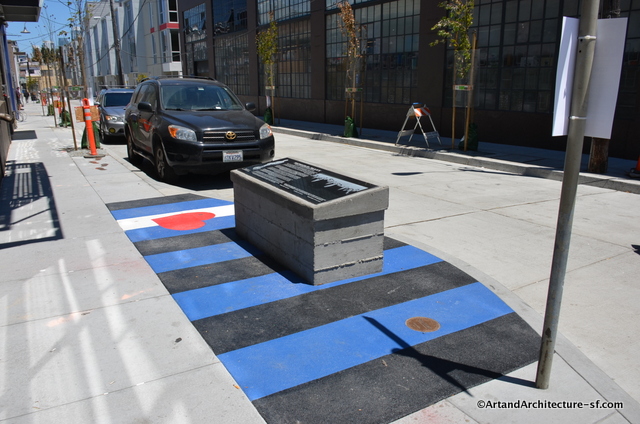
“Leather Memoir” consists of several custom fabricated features. A black granite marker stone mounted at 9th and Ringold features an etched narrative, which includes a reproduction of Chuck Arnett’s long-gone mural, and an image of Mike Caffee’s Leather David statue.
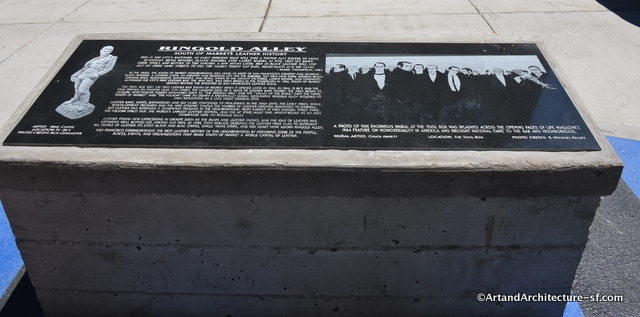
This is the city’s backyard. . . . An early morning walk will take a visitor past dozens of small businesses manufacturing necessities; metal benders, plastic molders, even casket makers can all be seen plying their trades. At five they set down their tools and return to the suburbs. . . . A few hours later, men in black leather . . . will step out on these same streets to fill the nearly 30 gay bars, restaurants, and sex clubs in the immediate vicinity. Separate realities that seldom touch and, on the surface at least, have few qualms about each other. –Mark Thompson (1982) – The first paragraph of the plaque.
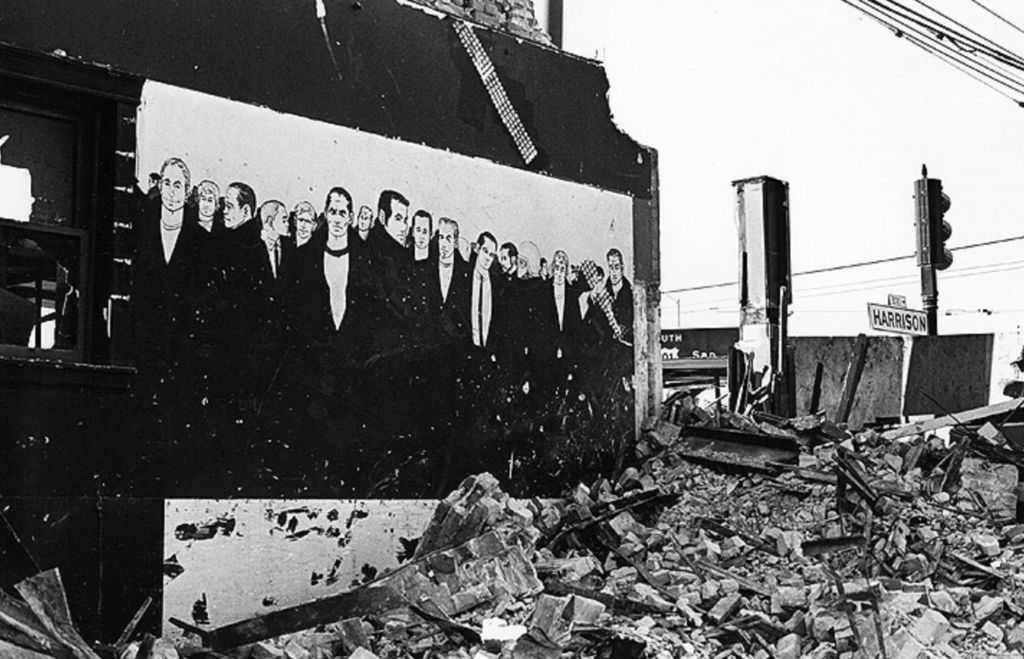
The Tool Box, at 4th and Harrison, was the prototypical San Francisco leather bar. Its walls were covered with murals by artist Chuck Arnett, whose work graced many other leather institutions over the years. A photo of the bar with many of the regulars standing in front of the Arnett mural appeared in LIFE magazine’s watershed 1964 photo-essay “Homosexuality in America.” This photo shows Arnett’s mural overlooking the rubble of the Tool Box. (1971)
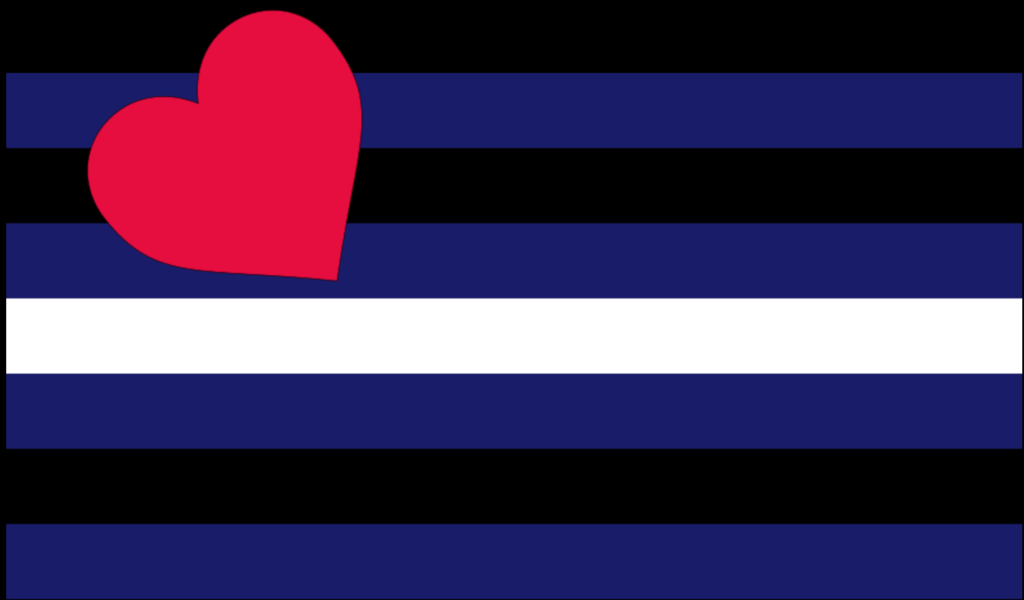
The paving around the granite installations is the Leather Pride flag, a symbol for the BDSM and fetish subculture
![The first leather bar on Folsom Street was Febe's, which opened July 25, 1966. In 1967 A Taste of Leather, one of the first in-bar leather stores, was established at Febe's by Nick O'Demus. Mike Caffee worked in and did graphic design for many leather businesses. In 1966, he designed the logo for Febe's and created a statue that came to symbolize the bar. He modified a small plaster reproduction of Michelangelo's David, making him into a classic 1960s gay biker: "I broke off the raised left arm and lowered it so his thumb could go in his pants pocket, giving him cruiser body language. The biker uniform was constructed of layers of wet plaster. . . . The folds and details of the clothing were carved, undercutting deeply so that the jacket would hang away from his body, exposing his well-developed chest. The pants were button Levis, worn over the boots, and he sported a bulging crotch you couldn't miss. . . . Finally I carved a chain and bike run buttons on his [Harley] cap." (Caffee 1997) This leather David became one of the best-known symbols of San Francisco leather. The image of the Febe's David appeared on pins, posters, calendars, and matchbooks. It was known and disseminated around the world. The statue itself was reproduced in several formats. Two-foot-tall plaster casts were made and sold by the hundreds. One of the plaster statues currently resides in a leather bar in Boston, having been transported across the country on the back of a motorcycle. Another leather David graces a leather bar in Melbourne, Australia. One is in a case on the wall of the Paradise Lounge, a rock-and-roll bar that opened on the site once occupied by Febe's.](http://www.artandarchitecture-sf.com/wp-content/uploads/2017/07/Screen-Shot-2017-07-17-at-3.16.50-PM-e1500329853808.png)
The first leather bar on Folsom Street was Febe’s, which opened July 25, 1966. Artist Mike Caffee worked in and did graphic design for many leather businesses. In 1966, he designed the logo for Febe’s and created a statue that came to symbolize the bar. He modified a small plaster reproduction of Michelangelo’s David, making him into a classic 1960s gay biker: “I broke off the raised left arm and lowered it so his thumb could go in his pants pocket, giving him cruiser body language. The biker uniform was constructed of layers of wet plaster. . . . The folds and details of the clothing were carved, undercutting deeply so that the jacket would hang away from his body, exposing his well-developed chest. The pants were button Levis, worn over the boots, and he sported a bulging crotch you couldn’t miss. . . . Finally, I carved a chain and bike run buttons on his [Harley] cap.” (Caffee 1997)
–Gayle Rubin, excerpted from “The Miracle Mile: South of Market and Gay Male Leather, 1962-1997” in Reclaiming San Francisco: History, Politics, Culture (City Lights: 1998)
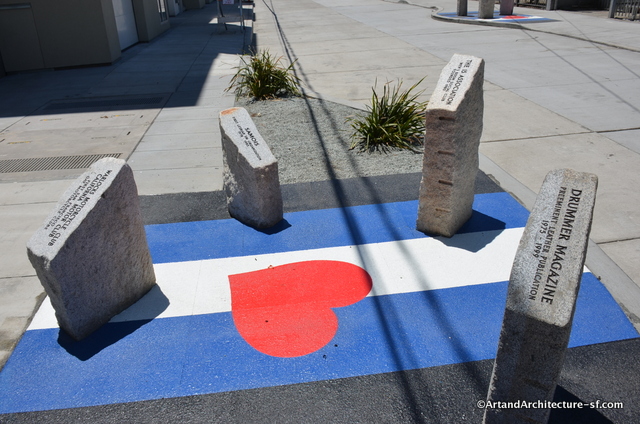
*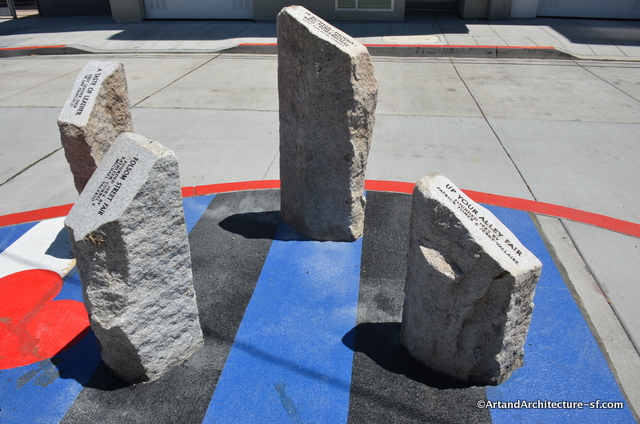
This 2016/2017 $2 million project was designed by Miller Company Landscape Architects. A variety of community leaders were consulted on the design, including anthropologist and leather historian Gayle Rubin, Demetri Moshoyannis executive director of Folsom Street Events, and the late Jim Meko, former chair of the Western SoMa Citizens Planning Task Force.
The project, officially known as the San Francisco South of Market Leather History Alley, was the brain child of Jim Meko, who, prior to his death in 2015, had long pushed for a rezoning of Western SOMA that would honor the area’s leather history. A bootprint honoring Meko can be found near the black granite explanation plaque.
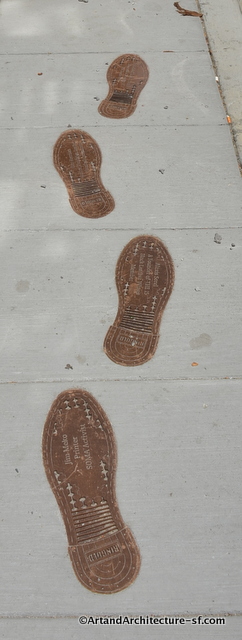
Made from the left and right soles of a pair of Dehner boots owned by Mike McNamee, the founder and former owner of Stompers, the 28 commemorative markers feature the names and short bios of 30 individuals. They can be found on both sides of the alley
If you are interested in learning more about the SOMA leather scene Found SF has written a concise and interesting story of the neighborhood, which you can read here.
Jeffrey Miller (ASLA) is credited as the lead artist on the project. Miller is the principal and founder of Miller Company. He holds an M.L.A. from the University of Massachusetts School of Landscape Architecture.
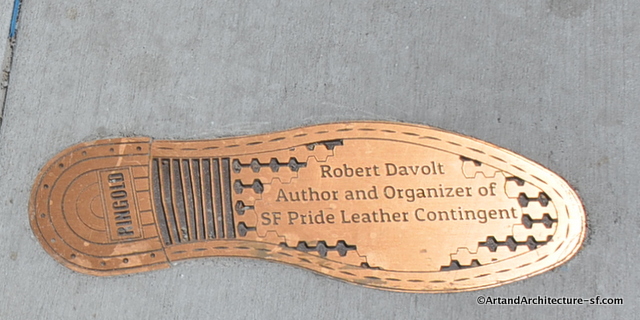 The people honored with boot prints are:
The people honored with boot prints are:
1. Jim Kane, community leader, and biker
2. Ron Johnson, poet, and co-founder of the Rainbow Motorcycle Club
3. Steve McEachern, owner of the Catacombs, a gay and lesbian S/M fisting club
4. Cynthia Slater, founder of the Society of Janus
5. Tony Tavarossi, manager of the Why Not
6. Chuck Arnett, iconic leather artist, Toolbox muralist
7. Jack Haines, Fe-Be’s and The Slot owner
8. Alexis Muir, a transwoman who owned SOMA bars and baths
9. Sam Steward, author, and tattooist
10. Terry Thompson, SF Eagle manager
11. Philip M. Turner, founder of Daddy’s Bar
12. Hank Diethelm, The Brig owner
13. Ambush co-owners Kerry Brown, Ken Ferguson, David Delay
14. Alan Selby, founder of the store Mr. S Leather and known as the “Mayor of Folsom Street”
15. Peter Hartman, owner of 544 Natoma art gallery and theater
16. Robert Opel, Fey-Way Studios owner
17. Anthony F. (Tony) DeBlase, creator of the leather flag
18. Marcus Hernandez, Bay Area Reporter leather columnist
19. John Embry, founder, and publisher of Drummer magazine
20. Geoff Mains, author of “Urban Aboriginals”
21. Mark Thompson, author of “Leatherfolk” and co-founder of Black Leather Wings
22. Thom Gunn, poet
23. Paul Mariah, poet, printer and activist
24. Robert Davolt, author, and organizer of SF Pride leather contingent
25. Jim Meko, printer, and SOMA activist
26. Alexis Sorel, co-founder The 15 and Black Leather Wings member
27. Bert Herman, author, and publisher
28. T. Michael “Lurch” Sutton, biker and co-founder of the Bears of SF